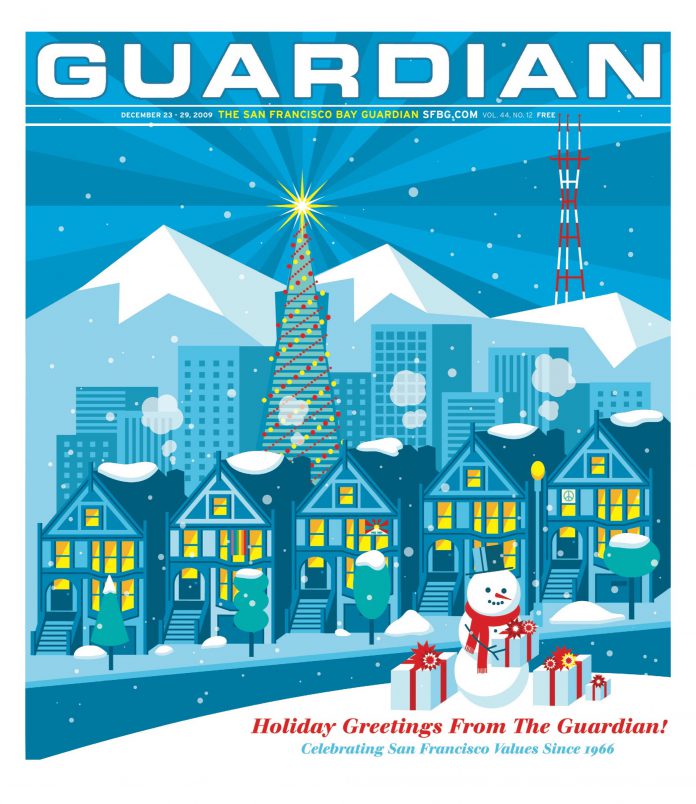1. SF garage rock goes pop This year saw Bay Area garage rock go pop in style and impact without losing its soul. I’m thinking of the Fresh and Onlys, and of Ty Segall’s second solo effort Lemons (Goner), a lovely one. I’m thinking of Girls’ Album (True Panther/Matador), which threw down the crossover-move gauntlet with no shame in its game: Christopher Owens’ interviews were as entertaining as his music and brasher — his real talk about sex and drugs made good headline fodder for the excitable British press, but contained the kind of truth that honors life over rules or boring definitions. The secret keeper, though, was the Mantles’ self-titled debut on Siltbreeze. Drew Cramer’s lead guitar and Michael Oliveras’ vocals were even better live, the mark of a band in bloom.
2. The AfroSurreal In May, D. Scot Miller helped put together a special AfroSurreal issue of the Guardian, a collection of words and visions journeying beyond the potential of Barack Obama’s presidency. The Kehinde Wiley piece on the cover wasn’t the only AfroSurreal image on this paper’s front pages — just last week, Conrad Ruiz’s Godzilla-size Yes We Can stomped around the city. Musically, AfroSurrealism manifested in the mind- and mirror-bending quality Dam-Funk’s Toeachizown (Stones Throw) and the rehab hallucinations and Dante-like funeral marches of Chelonis R. Jones’s Chatterton (Systematic). It floated in through cracks in the time warp as well: the ghetto opera of 24 Carat Black’s Gone: The Promises of Yesterday (Numero Group); the proto-punk of Death’s For the World to See (Drag City), especially “Politicians in My Eyes”; and weirdest of all, the gothic funk and skronk of Wicked Witch’s Chaos: 1978-1986 (E.M.).
3. 21st century goth From blackness to deathly whiteface — something gothic this way came in 2009, thanks to Cold Cave’s Cremations (Hospital Productions) and Love Comes Close (Matador). Both staked a claim that the genre is as applicable as death metal to a post-Bush presidency globe. But while those albums notched acclaim and attention, the similar yet more audacious Cure and Cabaret Volatire moves of Jones’ months-earlier Chatterton went ignored and unappreciated. Evidence of racism, proof that German techno only gets appreciated years after the fact, or both?
4. Hauntological mutations In 2009’s sonic mansion, ghosts haunted the hallways leading to and from the gothic banquet hall, and hauntology — a Derrida term applied to music by the critic Simon Reynolds — continued to morph, just as any self-respecting specter should, well beyond dubstep. The maze-like passages of Rooj’s The Transactional Dharma of Rooj (Ghost Box) and Broadcast and the Focus Group’s Broadcast and the Focus Group Investigate Witch Cults of the Radio Age (Warp) both suggested that spirits have short attention spans, while Demdike Stare’s Symbiosis (Modern Love) traded seances on wet afternoons for retro-futurist meetings with medieval wicked witches.
5. Library music For evidence that the past resides in and fuels the present, go to the library. Specifically, to the abundant compilations and Web sites dedicated to library music — the scores of incidental music produced and recorded for soundtrack use on film, television, and radio. In the wake of his gorgeous book The Music Library (Fuel Publishing), Jonny Trunk released more albums devoted to library labels. The Parisian DJs Alexis Le-Tan and Jess put out a pair of Space Oddities library collections — one electronic, one psychedelic — on Permanent Vacation. Wax Poetics published a lengthy piece to the subject. In an interview, Trunk noted that his Scrapbook (Trunk) shares the same fast-change aesthetics of Broadcast and the Focus Group’s hauntological recordings, just one example of how library music of the past forms the music of now.
6. The new ambient The new ambient is not afraid of extreme melancholy, or long compositions — no longer only Kompact, it can be epic. One of the form’s peak representatives is San Francisco’s Brock Van Wey, whose White Clouds Drift On and On (Echospace) bravely strived for, and sometimes reached, sublime solitude. Another was Klimek, whose Movies is Magic (Anticipate), on which a track such as “pathetic and dangerous” lives up to its death-knell title. The last was Leyland Kirby. His three-CD contribution sums up the current moment in both its title and the name of its label: Sadly, the Future is No Longer What it Was (History Always Favours the Winners).
7. 2009=1989, synthpop and shoegaze I explored this theme in last week’s Decade in Music issue. See: Atlas Siund (in particular “Shelia,”), Crocodiles, Fuck Buttons, Loop, Night Control, Pains of Being Pure at Heart, Washed Out (responsible for two of this year’s most gorgeous tracks, “Belong” and “Hold Out”), Wavves, and the xx.
8. How old is now? As the music industry continues to fracture, reissues or uncovered old sounds were as vital and revelatory as new releases. In San Francisco, this meant new rereleases by San Francisco Express, the Units, and most excitingly, Honey Soundsystem’s work on behalf of Patrick Cowley and Jorge Socarras’ Catholic project. Beyond SF, it meant a one-of-a-kind treasure like Connie Converse’s How Sad, How Lovely (Lau derette): one woman, one guitar, one tape recorder, and perhaps the best music of this sad, lovely year.

